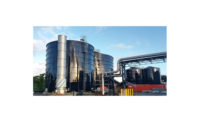“Our goal related to wastewater management as a protein processor is, full compliance at all times while optimizing the efficiency of the operations,” says Thomas Raymond, director of environmental sustainability at Hormel Foods. “Accomplishing this goal can be challenging when we are faced with evolving regulatory requirements and changes in wastewater characteristics due to the implementation of water-saving projects at our production facilities.”
Another challenge the industry faces is tighter permit limits placed on wastewater released to municipal treatment facilities or receiving streams, says John Askegaard, manager of new technology for Tyson Foods. Tyson constantly works to enhance its food safety initiatives, many of which involve water use. At the same time it looks into these areas within its processing plants, it studies areas that may present potential opportunities to save water, Askegaard says.
“Tyson Foods is continuously reviewing ways to improve our wastewater treatment processes,” he says. “Embedded within that effort is reduction of water use. Plants are being very inventive at identifying areas where water use can be reduced and formulating alternatives without compromising quality or safety. We implement best-management practices, employee education and various water-conservation measures in support of water reclamation as part of our efforts to conserve and reuse water.”
The company believes technologies are emerging now that will benefit the entire industry as it relates to wastewater.
“Tyson is evaluating and piloting several new technologies that have the potential to improve our specific wastewater processes,” Askegaard says. “These concepts are still under evaluation at this time.”
Hormel Foods also is taking steps to advance water conservation and wastewater treatment in its facilities.
“We have a longstanding tradition of investigating, reviewing and applying technology to improve our operations and minimize our environmental footprint,” Raymond says. “At our manufacturing facilities, we focus on reducing wastewater volume and strength at the point of generation. We continue to look at applying technologies and practices that improve manufacturing efficiency and improve equipment reliability.”
Hormel Foods’ recent advancements to manage water use and wastewater treatment have included installing closed water-cooling systems, investing in new wastewater treatment equipment, upgrading existing processes and working with municipal partners to identify long-term approaches that can meet a common goal of efficient and effective wastewater treatment. Although Hormel Foods regularly reviews new technologies for wastewater treatment to help achieve treatment goals, conservation continues to play a large role in its sustainability efforts.
“The application of advanced technology is important, but we must also continue to focus on source reduction and process efficiency as well,” Raymond says.
New technologies
In order to meet increasing government regulations on wastewater, some processors are constructing new facilities to manage new requirements. At the end of July, GNP Co. — formerly known as Gold’n Plump Poultry — finished a major wastewater expansion at its Cold Spring, Minn., facility to maximize U.S. Environmental Protection Agency and Minnesota Pollution Control Agency rules and limitations. The company spent two years researching new technologies for the wastewater facility, and environmental manager Clay Watson believes parts of the facility’s system are among the first in the poultry industry.
With a flow of about 1.4 million gallons a day, the chicken-processing facility already has experienced improved results in its wastewater treatment system’s turbidity, or the cloudiness of the wastewater, in comparison to its previous system.
“Typically a wastewater treatment plant’s water will have 8 to 12 turbidity going through the system, and now we are seeing turbidity of 0.1 to 0.3,” Watson says. GNP’s improvement in turbidity partially is achieved through membrane bioreactors.
“The wastewater gets vacuumed through little hallow fiber filters that have a 4-millimeter size opening, and you basically come out with what looks like drinking water,” Watson says.
The company’s new wastewater treatment plant operates 24 hours a day, seven days a week. With the facility upgrades, which include biological phosphorus and ammonia nitrogen removal, the company also has been able to achieve energy savings using new technologies. Another upgrade that has resulted in savings was the installation of an energy-efficient air blower system.
“Air is pumped into the aeration system, or the activated sludge, and also into the membranes,” Watson explains. “These blowers are the highest efficiency blowers on the market today. If you look at them, they almost look like a jet engine. The blowers run about 30,000 to 35,000 RPM and produce up to 2,800 cubic feet per minute. Once they get up to that level, they actually glide in air. There are no bearings. The blowers have a five-year payback.”
From a labor standpoint, the blowers also do not require any mechanical work, such as belt and oil changes, which can be hazardous, Watson says. In addition, the air blowers are set on variable frequency drives (VFDs) that are controlled by the amount of the oxygen reduction output, or dissolved oxygen, that the company logs in its aeration system. The only maintenance requirement is air filter changing.
“Once they are in place and running, they’ll just ramp up and down according to what the plant’s needs are,” Watson explains. On all of the facility’s pumps, GNP installed VFDs as well.
“They ramp up and down as needed by PLCs and by probes to maintain efficiency,” Watson explains. “So the VFDs are saving us a tremendous amount of energy costs.”
The probes the company installed also use advanced technology to deliver dissolved oxygen, and automatically inform the company how fit the wastewater material is, Watson says. In the past, the testing was done manually.
“We’re relying on automation,” Watson says. “By going with more automation, it’s allowed the operators to better maintain the rest of the plant and gained more overall efficiency in our operations, which will allow the plant to operate better in the future.”
Already having measured the carbon footprint for GNP’s Just BARE-branded products, the company is committed to reducing its carbon footprint. With plans of improved energy efficiency in the future, GNP installed solar panels on one side of its wastewater treatment facility and is selling that electricity back to its electric utility. Although the solar panels do not result in immediate cost savings, they help support the company’s long-range goal of becoming a sustainability leader in the industry, says Paul Helgeson, GNP sustainability manager, and fourth-generation team member from the Helgeson family — which founded GNP.
“The panels were installed because they help generate awareness for our commitment to renewable energy generation — it’s something visual,” he says. “That’s because it’s not just about the big things, but it’s also about the small things that lead to a significant impact over time in reducing our carbon imprint.”
The company also plans to add prairie grass and a stormwater pond. The challenge of any wastewater treatment plant is keeping the plant balanced. For any protein processor, the challenge is using the water and then putting it back into the environment better than it came in. Some of the data GNP has recorded so far has registered better than the data collected from water in the river, Watson says.
With the new facility, GNP has been able to re-use about 300,000 gallons a day of treated water in its processing plant in non-contact areas. The company started working with the U.S. Department of Agriculture and other government agencies about the potential of being able to use treated water in additional areas of the plant.
In addition, since 2000, GNP has centrifuged its secondary sludge and supplies the resulting product to a business that produces organic composting from it.
GNP built the new wastewater treatment plant with an eye on regulations and their potential effect on future production needs. Today, Minnesota’s regulations have applied a phosphorus limit to the company’s wastewater, which the new treatment facility meets.
“We were definitely limited on our flow prior to this construction,” Watson says. “Now the Cold Spring plant is able to process probably 15 to 20 percent more birds if they ever need to in the future. … The wastewater treatment plant will not be a stopgap.”
GNP continues researching new technologies for its facility, such as reverse osmosis, which could possibly bring its wastewater to drinking water standards.
“In terms of water and wastewater, I don’t think the technology will ever end,” Watson says.








Report Abusive Comment